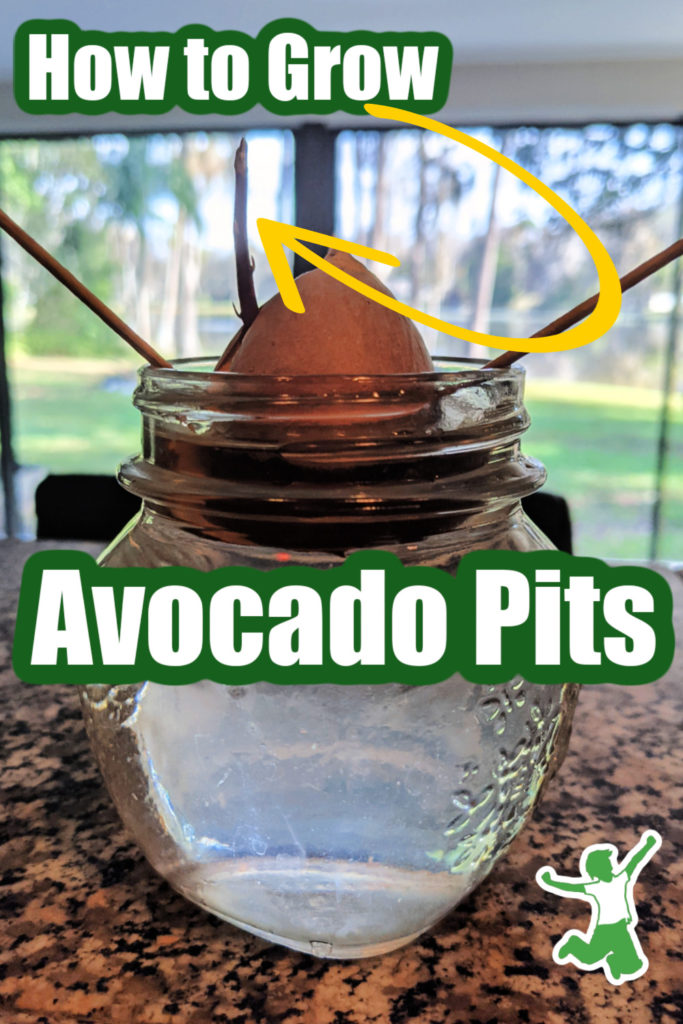How to easily sprout the pit of an avocado to plant and grow into a fruit-producing tree. Important tips such as what types of avocados work best and other tricks I’ve learned over the years so that your time and effort prove “fruitful”!

Avocados are one of the healthiest fruits to eat due to the large quantity of nourishing fats in avocado oil.
Since one of my favorite healthy breakfasts is easy and fast avocado toast, our family can go through quite a few avocados every month!
What to do with all those avocado pits?
It seems wasteful, at least to me, to just pitch them into the trash.
Composting the avocado pits to make nutritious mulch for your garden or potted plants is, at the very least, a good way to go.
Why Sprout an Avocado Pit?
If you live in a warm and semi-humid location with mild winters, then sprouting avocado pits to then plant and grow into a tree is my favorite way to go!
If you live in a cold environment, you can still sprout the pits and plant in a large pot for the porch or patio.
The tree won’t ever produce fruit this way, but you can create a lovely dwarf tree for ambiance and a fun conversation starter when friends come over.
If you already have an avocado tree or two in the yard, then give the prepared pits that are ready to sprout as gifts instead!
What Varieties Work Best
If you look around the supermarket or health food store, Hass avocados from Mexico are the most popular type available.
Farmers’ markets and locally owned health food stores or produce stands tend to offer more varieties.
Supermarket Avocados Don’t Easily Sprout
Unfortunately, I’ve not had much luck sprouting pits from commercial Hass avocadoes even when organically grown.
This isn’t to say that Hass will never sprout. I HAVE sprouted a few here and there. But, by and large, my attempts to sprout avocados from the supermarket don’t tend to be successful.
I don’t really understand why this is, to be honest.
My best guess is that avocados that pass through the industrial food system are irradiated or treated with something that prevents the pit from sprouting. In other words, commercial avocados seem to be sterilized somehow.
I do not have any evidence to back this up … if you know of some, please post links in the comments!
Locally Grown Work Best
In my experience, locally grown avocados from a small, independent health food store or fruit from a farmers’ market almost never fail to sprout.
Since I live in Florida, that means that the pits from Florida avocados are very fertile and sprout readily.
The picture above is of a Florida avocado that I sprouted on the kitchen counter. It will be ready to plant very soon!
Wherever you live, try to find avocados that are grown within your community or within a few hundred miles and trucked in directly from the farm.
Again, it is my hunch that the reason these are most fertile is that the avocados come to you direct, bypassing the industrial food system.
There is no intervening step where the avocados are subjected to some sort of “safety processing” that eliminates the fertility of the pit.
How to Sprout and Grow an Avocado Pit into a Tree
Once you have an avocado available at home that you’d like to sprout, here are the steps to take.
Sprouting the Pit
- Remove the pit from an avocado that has been carefully sliced open.
- Wash the pit gently in cool filtered water. Do not use soap and do not use tap water, which is chlorinated and will kill the protective probiotics on the surface of the pit.
- Dry the pit with a clean cotton dishcloth.
- Take three wooden (NOT plastic) tooth picks and insert at 120 degree angles at the midsection of the pit. The widest part of the pit should be vertically pointing to the ground. See picture above for specifics.
- Suspend the pit on the rim of a small glass jar and add filtered spring water (NOT tap or RO which is devoid of minerals) to the point where the water level is just below the toothpicks. About half the pit should be submerged.
- Leave on the kitchen counter that gets indirect sunlight only. A window sill, the top of a refrigerator or a dark cabinet are not choices that are likely to be successful.
- Top up the glass with more filtered water as needed. Refresh all the water in the glass once a week.
- Within 4-12 weeks, a crack will start forming on the avocado pit and a sprout and roots will begin to emerge. The stem on the pit in the photo above appeared during the sixth week. The stem and roots may not appear at the same time.
Growing into a Tree
- When the sprout is about 6 inches long and the roots well developed (at least 2-3 inches long), carefully remove the toothpicks and plant the pit in soil in a medium sized pot. The top of the pit should be level with the surface of the soil.
- Place the pot in a sunny location (east/west window or outside location on the patio or porch is ideal). Water frequently enough to keep the soil moist (not wet or dry). Fertilize twice a month with organic houseplant fertilizer during spring and summer.
- Repot the avocado tree once it becomes too large for the starter pot. Use a larger container or (best) replant in your yard as desired.
- If you keep the tree potted, it will remain small and never produce fruit. It will be a lovely tree nonetheless!
- If you replant in your yard and regularly fertilize, the rapidly growing tree will begin producing avocados within about 3-5 years. Remember, an avocado tree with plenty of room will eventually grow about 40 feet tall, so plant it away from the house and other trees with that in mind.
Have you sprouted an avocado tree from a pit before? What variety did you use and where did you purchase the fertile avocado?









Are avocado pits edible?
I’ve always wanted to try this! How cool of a project this will be, thanks for the inspo!